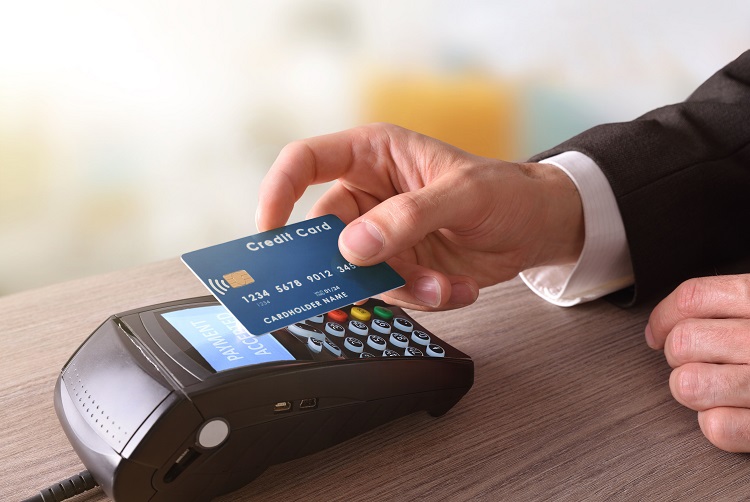Top-Level Takeaways
-
Consumers are set to adopt contactless cards en mass over the next couple of years as mass transit systems and other points-of-sale begin accepting the wave-and-pay plastic.
-
Experts predict the price for the cards will come down as demand ramps up.
-
Educating members on the advantages of wave-and-pay will underpin acceptance.
Following the path forged by EMV chip cards before them, contactless plastic is expected to ride a major wave of adoption this year and next.
In fact, they’ll be on the same card. The wave-and-pay functionality of contactless cards resides in a chip embedded in tandem with the EMV chip that is now so ubiquitous that Visa says 96% of its point-of-sale volume is made using those cards.

Jamie Topolski, Director/Product Strategy, Fiserv
The contactless function also known as contactless EMV requires a new type of plastic, a dual-interface card that accommodates contact and contactless technology. They have an RFID chip that communicates with the payments terminal through the Near Field Communication (NFC) protocols, the same technology that powers wave-and-pay mobile wallets. That process creates a single-use code, called a token, that allows the transaction to proceed securely.
The same process occurs on the contact side of the interface, when the EMV chip creates a code when it’s inserted, or dipped, into the reader. Traditional magnetic swipe stripe functionality also is retained on this plastic.
The attraction of these cards is three-fold: They’re convenient, secure, and competitive. The transactions are faster to complete yet offer the same security that has thwarted so much card-present fraud. They also are a way for issuers to stay top-of-wallet and play to the known preference a majority of consumers show for using credit cards for daily transactions.
Contactless cards help to grow transaction volume by displacing cash and positioning the card at the top-of-wallet since they deliver a faster and more satisfying shopping experience, says Jamie Topolski, director of product strategy for Output Solutions at Fiserv.

A user waves a contactless card at an NFC-enabled POS terminal. Image courtesy of PSCU.
Acceptance And Expectation
Merchant acceptance and consumer expectation will drive the use of contactless cards. In this case, merchant deployment is the chicken before the egg. The technology has to be available at the point-of-sale for consumers to use the dual-interface cards.
That appears to be rapidly happening. Estimates vary, but, generally, experts say approximately 65% of U.S. merchants will be accepting contactless cards at POS by the end of this year.
Visa says 95% of the terminals it now ships are enabled for contactless transactions. Additionally, three-fourths of the top 100 merchants including Target, Trader Joe, Whole Foods, and Costco have or are about to have that functionality available at the physical point-of-sale.
When the big guys the large issuers start ordering mass quantities of that plastic, that’ll begin driving the price down. That will also be our opportunity to go in as a CUSO and negotiate on behalf of 900-plus credit unions to get that advantage of scale and pass it on.
Among the major issuers in credit union land, PSCU says it has more than a dozen early adopter credit unions offering the cards already and expects hundreds more to follow suit in the coming months. CO-OP Financial Services says approximately 70% of its larger full-service credit unions have begun issuing dual-interface cards.
We see consistent growth as more credit unions become educated on the benefits of contactless for the credit and their members, says Vickie Walker, senior product manager/debit for the big California CUSO. Contactless is growing in acceptance where members are looking to perform faster payments, such as at fast food restaurants and mass transit stations. This demand has motivated credit unions to transition to contactless.
Economy Of Scale

Chuck Fagan, President and CEO, PSCU
The public transit systems in major markets including New York, Boston, Atlanta, and Chicago have adopted contactless card functionality or are expected to soon. That makes sense for the vending machine lines for which no one wants to be the commuter holding up the line.
Transit adoption is set to ignite the power of another market force supply and demand that should put competitive pressure on the price of the cards themselves.
When the big guys the large issuers start ordering mass quantities of that plastic, that’ll begin driving the price down, says Chuck Fagan, president and CEO at Florida-based PSCU. That will also be our opportunity to go in as a CUSO and negotiate on behalf of 900-plus credit unions to get that advantage of scale and pass it on.
Find your next partner in Callahan’s online Buyer’s Guide. Browse hundreds of supplier profiles by name, keyword, or service area.

Tony DeSanctis, Senior Director, Cornerstone Advisors
The price of the plastic currently varies from $1 to $2 or more per card depending on the size of the institution, estimates Tony DeSanctis, senior director at Cornerstone Advisors.
That’s a hefty price tag but Jeremiah Lotz, vice president of product management at PSCU, says credit unions fork over the funds might be in for a pleasant surprise.
It’s crucial that credit unions be early adopters of contactless EMV, Fagan adds.
According to Lotz, most nations have seen an increase of three to five transactions per card in the first year of contactless rollout, growing to an average of 20% to 30% lift in the number of transactions per card in U.S.-like countries in the third year after rollout.
How To Issue, When To Issue
Then there’s the question of how and when to issue, the same decision that had to be made when it was time to deploy EMV chip cards. Each credit union will have to decide what’s best for its shop.
4 Tips To Go Contactless
Jamie Topolski, director of product strategy for Output Solutions at Fiserv, shares five best practices for credits unions considering or preparing a rollout of contactless cards.
- Evaluate readiness of current vendors to gauge if they can support contactless.
- Develop a business case for deployment.
- Evaluate the competitive landscape to determine how soon to adopt.
- When possible, coordinate migration to contactless when chip cards are expiring.
Do they do a mass reissue when undergoing a brand change or updating to new card programs? asks Lotz at PSCU. Or will they focus on a natural reissue where new cards are circulated if a member’s card is lost, stolen, or expires?
DeSanctis offers four pieces of advice. First, there’s no need to mass issue. Second, target high transactors first. Third, put education in place about the benefits for members and staff. And, finally, reinforce the security message that contactless EMV is just as safe as chip EMV and twice as fast.
The education message resonates with Walker at CO-OP, where the senior product manager for debit says raising consumer awareness is a primary challenge.
It’s a behavioral change for the member from swiping or dipping to tap-and-go, she says. But credit unions can encourage that behavior by emphasizing the security benefits and convenience.
Members have long heard about the security risk when making payments with the magstripe card, Walker says. Transitioning them to a dual-interface card to perform contactless payments is the perfect solution.
It’s All About The Experience
Credit unions that still remember the EMV rollout and those well-publicized reports of chip card transactions taking several seconds to process and worries about pushback at the checkout line might be hesitant to jump on board with contactless. But they shouldn’t be.
From a member perspective, contactless cards speed the point of sale relative to a chip transaction and are more in line with legacy swipe transactions, DeSanctis says. The opportunity for the credit union, meanwhile, is to demonstrate it is forward thinking in relation to new technology and member experience.
Also On The Payments Beat:
-
A Zest For Zelle Drives Early Adoption At 2 Credit Unions
-
A New Way To Pay: Mobile Wallets And The Path To Credit Union Adoption
-
The Payment Rail Rolls On Despite Delays In ACH Window
But, just like EMV cards, which became more ubiquitous as the liability shift deadline neared in 2015, contactless adoption may become a fait accompli even as leading edge credit unions study the ramifications.

Terry Rodrick, Vice President of Cards Payments, First Tech FCU
That includes First Tech Federal Credit Union ($12.2B, San Jose, CA), where VP of cards and payments Terry Rodrick says, It’s on our roadmap for 2020 consideration.
The fairly rapid clip of marketplace growth at the point of sale has displaced the questionable inevitably of a few years ago, replacing it with a realization that contactless cards are likely to be seen as a plastic standard that most consumers will expect in the next one to three years, Rodrick says.
She adds, That being said, our particular EMV profile makes it a bit more complex. We have some research underway to understand what our member experience would be like since we are chip-and-pin instead of chip-and-sig. We’re still researching the best approach for rollout.


